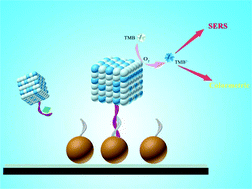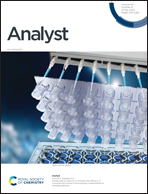A sensitive and simple competitive nanozyme-linked apta-sorbent assay for the dual-mode detection of ochratoxin A†
Abstract
The enzyme-linked apta-sorbent assay (ELASA) is widely used for the detection of small-molecule compounds as a result of low cost and reagent stability of aptamers. However, enzyme labels used in ELASA still suffer from some drawbacks, such as high production cost and limited stability. To overcome the drawbacks, we reported a nanozyme-linked apta-sorbent assay (NLASA) coupled with surface-enhanced Raman scattering (SERS)-colorimetric dual-mode detection. For nanozyme labels, Pd–Pt bimetallic nanocrystals (Pd–Pt NRs) could catalyze 3,3′,5,5′-tetramethylbenzidine (TMB) to blue TMB2+, whose color variation could not only be distinguished by naked eyes but also had a strong SERS signal. The NLASA method was employed to detect ochratoxin A (OTA) with a limit of detection values of 0.097 nM (0.039 ppb) and 0.042 nM (0.017 ppb) via the colorimetric and SERS methods, respectively. This method was applied for the determination of OTA in wine and grape samples, and the detection results were in a satisfied agreement with those determined by the high performance liquid chromatography tandem mass spectrometry (HPLC-MS/MS) method. The proposed NLASA method provided a rapid and sensitive detection for OTA and could also be broadened for other small-molecules.



 Please wait while we load your content...
Please wait while we load your content...